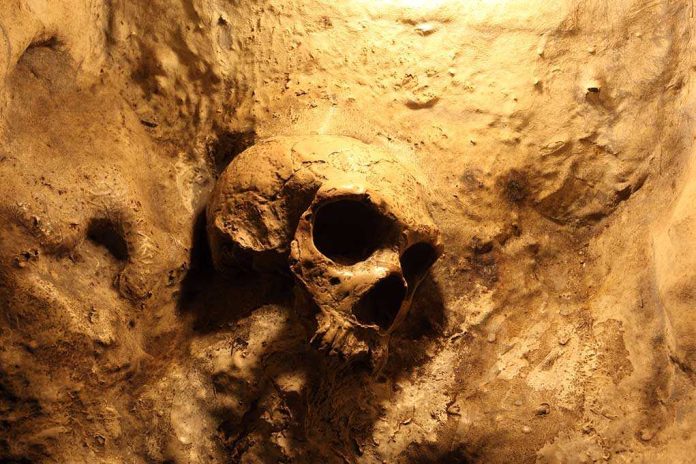
A 3,000-year-old secret, hidden beneath Scottish soil, has forced historians to rethink the very nature of Bronze Age wealth and ingenuity—leaving one question echoing: how did ancient Scots create treasures that have no equal anywhere in the world?
Story Snapshot
- The Peebles Hoard contains over 500 Bronze Age artifacts with unique silver-coloured objects never before seen in archaeology.
- A deliberate tin enrichment technique produced the remarkable silver finish, defying expectations of the era’s technological limits.
- National Museums Scotland is leading an intensive, multi-year conservation effort to unlock the full story of the hoard’s origins and meaning.
- The discovery shines a spotlight on Scotland’s ancient societies, raising new questions about their craftsmanship, status, wealth, and cultural connections.
The Day the Borders Changed: Discovery of the Peebles Hoard
Mariusz Stepien, a metal detectorist with a passion for forgotten histories, swept his device across a nondescript field outside Peebles in the Scottish Borders. What he found beneath the surface—a cache of swords, chariot fittings, and dazzling silver-coloured objects—triggered an archaeological earthquake. The sheer volume and uniqueness of the Peebles Hoard stunned experts, forcing a rapid, careful excavation. News spread: Scotland’s Bronze Age was far richer and more mysterious than anyone had guessed.
The find, now under the custodianship of National Museums Scotland, instantly became one of the most significant Bronze Age discoveries on British soil. While metal detectorists have uncovered treasures before, nothing matched the Peebles Hoard’s diversity or the riddle of its silver sheen. It was not just another trove—it was a message, 3,000 years in the making, waiting for modern science to decode.
Secrets of Ancient Craftsmanship: The Silver-Coloured Enigma
Bronze Age Scotland, more often associated with rugged roundhouses and earthy pottery, suddenly revealed a new face: one of deliberate artistry and technological prowess. Among the hoard’s 500-plus objects, several bore a silver-coloured finish—a striking anomaly, since true silver was virtually unknown in the region during that era. Analysis revealed a masterstroke: the ancient smiths had enriched the surface of bronze objects with tin, creating a silvery appearance that mimicked precious metal. This was no accident; it was a calculated display of wealth and status, carefully engineered to dazzle both friend and rival alike.
Experts like Dr. Matthew Knight of NMS called the tin-enrichment technique “without parallel,” challenging old theories about Bronze Age technology. The process required both metallurgical expertise and artistic vision, suggesting that the people behind the hoard were not provincial farmers but sophisticated craftsmen with access to wide-ranging knowledge and resources. The implications ripple outward: who were these artisans, and what networks or influences allowed such innovation in the remote Scottish Borders?
Conservation and the Ongoing Race Against Time
Once the initial wonder faded, the hard work began. The Peebles Hoard’s preservation became a high-stakes race against decay. National Museums Scotland—backed by The Leche Trust, The Pilgrim Trust, and private donors—launched a meticulous conservation project expected to last three years. Conservators, including Bethan Bryan, faced daunting challenges: many artifacts included delicate organic materials like wood and leather, rarely surviving from the Bronze Age. Each item required individualized care to reveal its secrets without destroying fragile evidence.
The Peebles Hoard is a spectacular collection of bronze, leather and wooden material, dating to the Late Bronze Age (c.1000-800 BCE) https://t.co/pilGq4vMn0
— Chris Stringer (@ChrisStringer65) November 7, 2024
Every step of the process, from x-rays to microscopic analysis, added a new chapter to the hoard’s story. As conservators worked, they uncovered evidence of trade, ritual, and perhaps even ancient theft or diplomacy. Yet, the greatest mystery remains: the precise purpose of many objects is still unknown, keeping experts and the public alike guessing about the lives and ambitions of those who buried these treasures millennia ago.
The Peebles Hoard’s Lasting Impact: Heritage, Identity, and the Power of Discovery
The Peebles Hoard’s influence extends far beyond the confines of museum storage and laboratory benches. For the Scottish Borders, the discovery is both a source of local pride and a magnet for cultural tourism. The story has sparked renewed interest in Scotland’s ancient past, attracting new generations to archaeology and heritage preservation. For academics, the hoard is rewriting the narrative of Bronze Age Europe, forcing a reconsideration of Scotland’s connections with distant cultures and its own internal hierarchies.
Politically, the find underscores the value of robust cultural preservation policies and the unintended but vital role of responsible metal detectorists. Socially, it reminds modern Scots—and anyone drawn to the mysteries of history—that even the most unremarkable fields may conceal wonders capable of reshaping national identity. As conservation continues and new analyses emerge, the Peebles Hoard will remain a touchstone for those who seek to answer the oldest questions: who were we, and what did we value most?
Sources:
Magical Moment: 3,000-year-old Secret of the Peebles
Hoard of Treasure 3,000 Years Old
The History Blog – Peebles Hoard
Heritage Daily – Peebles Hoard Revealed












